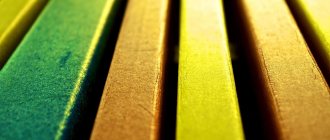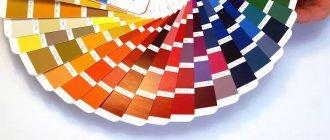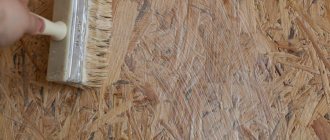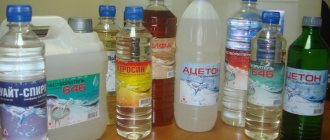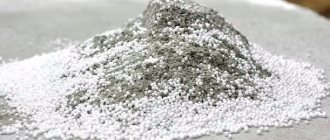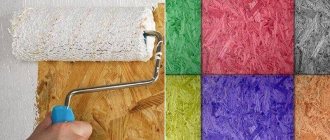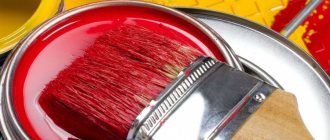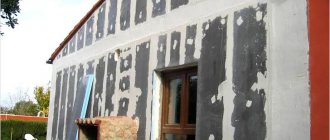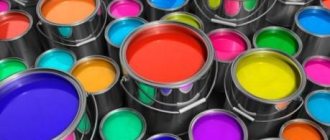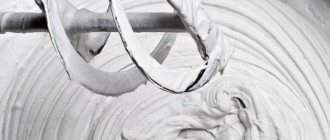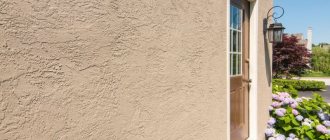Paint for plaster, brick, concrete - the main advantages of use
Decorative color coating is applied to facade walls in order, firstly, to increase the aesthetics of the building’s appearance, and, secondly, to enhance the performance of the structure.
Thanks to the film that is formed as a result of applying paints and varnishes, the risk of excessive moisture on external walls is reduced and thus the destruction of load-bearing structures and foundations is prevented. Construction experts say that painted buildings are much less likely to need major repairs.
Thanks to modern paints, walls do not retain steam, and condensation, which constantly forms due to the temperature difference between external and internal surfaces, does not have time to accumulate. Therefore, the reasons for the formation of mold and fungi, which can destroy even stone buildings in a short time, disappear.
Any facade paints for brick, plaster and concrete are practically not subject to the negative effects of winds, precipitation and temperature changes. Thanks to modern manufacturing technologies, the colors of paint compositions almost do not fade even in the bright sun and retain their richness and decorativeness for a long time.
Since the range of paints and varnishes in construction stores is quite wide, you can decide in advance which paint is best to use to decorate your home. However, it is better for inexperienced builders not to select decorative coatings on their own, but to do it together with a specialist in this field.
Oil and alkyd paints
Such paints are characterized by rich color and a durable layer after drying, but they have some disadvantages. Namely:
- Strong toxic odor. It is difficult to work with such paint, and not everyone can do it. After it dries, there will be no odor, but even your neighbors will feel the paint fumes during operation.
- Small selection of colors and shades.
- High consumption of paint and its high cost.
- If you work with a roller or brush, the painting speed will be slow.
In general, painting plastered walls with such materials is often used, especially in rooms with high humidity. The service life of such surfaces will be long and will not require intensive care.
Varieties of painting compositions for house facades on plaster
Before you paint the plaster, you should get acquainted with the types of paint coatings and choose the right composition for finishing the house.
Silicone paints for exterior and interior use
When deciding how to paint the facade of a house over plaster, many beginners and experienced builders choose silicone coating, which is highly wear-resistant. This composition consists of polymers, thanks to which it is possible to form a waterproof surface on the external walls, protecting the plaster on the facade from waterlogging.
The coating is resistant to mechanical damage; surfaces treated with this composition acquire hydrophobic qualities and retain vapor permeability. Therefore, the premises maintain a favorable climate and optimal humidity levels. The film formed by silicone paint does not conduct electricity and does not accumulate it.
Silicone compounds are compatible with any type of coating; they fit well on old substrates with mineral coatings, acrylic, latex paints, on products made of plaster, wood, and metal.
When using silicone-based paints, it is not necessary to treat surfaces with an antiseptic primer, since these materials can inhibit the activity of pathogenic microorganisms.
Among the advantages of using this building material is a wide palette of shades and colors, it is odorless and may not require repair for more than 20 years. The disadvantage of silicone paints is their high cost. However, high-quality coating and long service life fully pay off.
When choosing a material, you need to take into account that silicone paint for plaster is not suitable for interior work when painting facade walls, since it is not resistant to weather conditions.
Lime paints for exterior plastering and interior walls
A popular and relatively cheap paint that is applied to plastered exterior walls is made from slaked lime. It has increased bactericidal properties, so mold never forms in places where the lime composition is used.
The coating layer of this paint has high vapor permeability. However, this material has a big drawback - it is not resistant to moisture, so it can easily be washed off with water. After prolonged rainfall, streaks may form on the walls, which must be periodically painted over. Every season, façade walls covered with lime paint need to be renewed.
Lime materials are used to paint the exterior surfaces of buildings.
Achieving the desired shade when painting can also be difficult. The color palette consists of white and several pastel halftones. In addition, concrete bases are quite difficult to paint over with lime compounds. The rough texture shows through even under a thick layer, and the finish looks untidy.
Cement paints for facade plaster
Novice builders are often interested in whether it is possible to paint facade walls with cement paints. These materials are made on a mineral basis. The composition includes white Portland cement and a certain amount of coloring pigments.
These paints have a more durable texture than lime paints, and the applied coating is resistant to moisture. But at the same time, cement paints do not have bactericidal qualities, and even a recently applied coating can quickly become stained with mold and mildew. Therefore, due to such features, cement paints, despite their low cost, are practically not used in modern construction.
Latex paints for walls on plaster
To paint plastered walls outside the house, you can use latex paints and varnishes (in the construction industry they may be called acrylic paints). These paints contain a small amount of rubber, which gives them strength and ductility and prolongs their service life. You can buy a white latex base compound in stores. To get the desired shade, you need to add a color that has the consistency of a paste.
Latex paints are expensive, so it is advisable to first calculate the material consumption and estimate the cost of repairs. This composition has a thicker consistency than, for example, water-based paint, so in some cases its consumption during painting may be indicated in grams per 1 square meter. m. Different manufacturers' products may differ in consistency, and dye consumption varies widely - 90-200 g per 1 sq. m. m.
When applied to a surface, it is permissible to dilute them with clean water up to 5% of the original volume. The drying time of such a coating, depending on weather conditions, is 1-5 hours.
Among the advantages of this paint are environmental friendliness and the absence of a specific aroma, which often remains after painting work. As a result of the latex coating, a dense glossy or matte waterproof film is formed on the surface, resistant to weather conditions, low and high temperatures, as well as mechanical and chemical influences. This paint is well suited for painting walls made of all types of materials, including those plastered with gypsum, cement or lime mortars.
Another advantage of acrylic facade paints is their rich, bright colors that do not lose their original shades for a long time and do not require annual renewal.
Which is better to choose?
First of all, it is necessary to prioritize the quality of the product. To do this, before choosing a suitable paint, you should familiarize yourself with the features of the room and the properties of the product.
Depending on the temperature and humidity level of the room, the paint may be suitable for use or vice versa. Some foods tend to spoil at low temperatures or high humidity.
If the question of how to paint a plastered wall in a children’s room is being decided, then preference should be given to environmentally friendly materials. For the corridor and kitchen, it is advisable to use washable paint for interior plastering work. This will become a long-term option. The product must be moisture resistant and antibacterial.
Criteria for choosing paint for exterior use
For the final finishing of the facade, plaster paints cannot be used for interior work. They do not have a margin of safety and will not be able to withstand atmospheric conditions and temperature changes.
Therefore, when choosing a coating for painting work that will be carried out outdoors, the following factors must be taken into account:
- Materials for painting the facade must be high-strength and wear-resistant, so that the next repair can be planned only in a few years.
- They must be resistant to ultraviolet rays, not fade or lose their attractive appearance when exposed to sunlight.
- One of the most important indicators is a high degree of water resistance, which serves as a guarantee against the appearance of dampness, mold and mildew indoors.
- The paint should be quite economical and have a consumption level of no more than 200-300 g per 1 sq. m. m.
- You should pay attention to the expiration date of the product. The fresher the paint composition, the easier it is to apply and the better the final coating looks.
- You need to make a choice between matte and glossy paint. In the first case, the coating will effectively hide all the unevenness of the wall, but will not have a bright shine. But glossy compounds can only be applied to flat surfaces, which is not always possible to achieve when doing DIY repairs.
PVA-based water-based paint
Water-based paint, which is based on PVA, is quite a convenient option for painting walls in the “cheap and cheerful” style, and also with a good appearance . Although this water emulsion does not have a wide choice of colors, it is simply created for a room in which there is no need for a special design and color saturation. The main thing to remember is that water-based emulsion material cannot be used in rooms with high humidity, as well as in places where it can be wiped with wet wipes.
Need to know! For color saturation, PVA-based water emulsion must be applied in several layers. For a stronger effect, it is advisable to prime the wall of the house before work. Such an event, first of all, will strengthen the adhesion of the paint to the plastered surface, and will also reduce the consumption of the water-based composition.
Water-based waterproof paint based on PVA with the addition of acrylic
Paint consumption for the facade of the building and for interior wall decoration in the apartment
Paint consumption must be determined at the very beginning of the repair so that you can plan an estimate of upcoming costs.
To determine the optimal amount of dyes, it is necessary to find out not only the total surface area, but also the consumption per 1 square meter. m. This figure may vary for different compositions. Most often, manufacturers of paint and varnish products indicate the average consumption rate on the packaging of the paint can. However, it is worth considering the features of the walls on which the color is to be applied.
For example, a surface without putty, like a gypsum base, will need much more coloring composition, since it is absorbed well. Therefore, to achieve a bright final coating, you will need to apply 2-3 layers of color.
The coverage area can be calculated using the formula: “height times width.” If there are window and door openings in the wall, you need to calculate their area and subtract this amount from the total figure.
Manufacturers most often indicate standard indicators on a paint can - material consumption per 1 square meter. m. It is necessary to multiply the average by the area of the wall to obtain the rate of paint consumption to cover it in 1 layer. If you plan to apply several layers, the resulting figure must be multiplied by their number.
It is better to purchase consumable paint and varnish material with a reserve in case of unforeseen situations. Even if the paint remains, it can be sealed tightly and left to recoat if the need arises.
Painting walls with plaster finish
Before painting walls covered with gypsum plaster, it must be puttied. The use of putty is considered a mandatory step in finishing drywall sheets with paints and varnishes. If this step is not completed, there is a risk of lack of adhesion between the paint and the gypsum plaster.
To work with putty plasterboards, water-dispersed and acrylic compositions are used. The latter must be made on the basis of water.
The whole process of finishing walls with gypsum plaster looks like this:
- Cleaning the surface of sheets and trimming edge seams.
- Filling joints with serpyanka. At this phase, a starting putty is used, which is intended for rough surface treatment.
- Treating the entire surface of the wall with putty to hide the screw heads and possible cavities.
- The second layer, on which the finishing putty is applied.
- Grout the wall using a float and sandpaper.
- Priming the surface, as well as simultaneously removing dust and dirt.
At the end of these activities, the gypsum-type plaster is painted after puttying. For this purpose, rollers and brushes are used; for convenience, a special container for rolling out tools is used.
Use a thin brush to work the corners of the drywall. Painting walls with one roller is inconvenient due to its dimensions. The most optimal would be a roller with a medium length of pile.
In the video: painting walls after plastering.
How best to paint a façade over plaster on the street - a step-by-step plan for finishing work
Before you paint the plaster yourself, you should purchase all the necessary materials and tools and carry out the required preparatory work.
In addition, you need to carefully study the technology of painting walls after plastering so that the result does not disappoint later.
How to choose tools for working on plastered walls
When doing painting work yourself, you need to purchase in advance not only building materials, but also available tools.
What you will need:
- A wide brush or roller with a removable handle so you can adjust its length. Roller attachments should be made of synthetic plush or polyacrylic; the length of the pile may vary. It is believed that for applying a decorative coating over plaster, a pile no shorter than 9-11 mm is best suited.
- Several brushes for applying paint - wide ones for covering basic surfaces, and narrow ones for thoroughly painting hard-to-reach areas. In some cases, a wide brush can be replaced with a paint roller.
- If it is expected that when finishing the plaster layer, additional areas of decorative surface will be created (for example, granular or patterned), you should purchase rollers with textured nozzles.
- If a white base is chosen as a coating, you may need a set of colored colors to dilute it.
- To paint a plastered wall with high quality, you need to achieve its smoothness, so you should buy a special grater for sanding small irregularities. If the area of rough surfaces is small, you can get by with sandpaper of varying degrees of grit.
- You will need a large tray for the paint. It should be selected taking into account the width of the roller. Experienced builders advise that in order not to throw away a contaminated container after repairs, before pouring paint into it, put a layer of polyethylene inside. Once painting is completed, it can be rolled up and disposed of, leaving the tray clean. Therefore, you can stock up on cellophane.
- For working at height, you will need a stable stepladder.
- Be sure to take care of personal protective equipment - gloves, gown, hat.
Before painting façade walls, it is advisable to assess the scope of work. If the area is large enough, it is recommended not to paint by hand, but to purchase or rent a spray gun. With its help, you can finish several walls with high quality in a short time and without much difficulty.
The stage of wall preparation before applying wear-resistant wall paint
In order for façade paint on plaster for exterior work to lay smoothly and evenly on the base, and in the future to serve as long as possible, the walls must first be properly prepared.
First of all, all surfaces must be carefully inspected and cleaned of dirt and dust. If there are rust stains or traces of fungus on the walls, they must be removed. You should use a liquid cement solution to repair all cracks, irregularities, chips and potholes and carefully level the surface. If the plaster of painted walls is damaged, it needs to be renewed.
When all the imperfections have been eliminated, the base must be sanded so that the top decorative layer is smooth. Sanding can be done using either coarse- or fine-grained sandpaper or a special sanding machine. However, in this case you need to have some skills in working with the device.
In order for the façade paint to lay evenly, the prepared walls must be primed with special compounds. They can be purchased at construction stores. It is advisable to choose materials that are suitable for external work. Experts recommend priming the base twice. Moreover, each layer must be allowed to dry completely before painting the walls.
Technology of painting facades with weather-resistant paint
Novice builders should know that painting facade plaster can only be done at a temperature not lower than +5°C, otherwise the fresh coating may be exposed to low temperatures. In this case, it will not be able to dry well and will soon fall away from the surface and crumble.
Before complete drying, it is undesirable for the wall to be exposed to moisture and direct rays of the sun, since uneven drying will cause stains to appear on it. Therefore, for façade painting work, you should choose cool, dry days.
Painting on an already prepared wall should begin by diluting the paint composition. If you decide to decorate the façade with a white color scheme, you can begin work immediately. But in most cases, owners of private houses prefer rich and bright colors. In such a situation, you need to mix the desired shades, apply a little of the composition to the wall in an inconspicuous place, let it dry completely and evaluate the result. The finished coating will be slightly lighter than the paint in the tray. If necessary, the proportions of colors can be changed to achieve the desired shade.
But if pigments are added to a white base, you should immediately dilute them in a large container. Because if a small amount of paint is not enough to cover the entire surface, then it is rarely possible to repeat the shade and re-mix the color in the required proportion.
Before painting plastered walls, you need to take care to protect window frames, cornices, door jambs and other parts that are not planned to be painted from the paint. To do this, they need to be sealed with masking tape. If you plan to work with a spray gun, it is better to cover all openings with cellophane film or thick covering material.
It is best to start painting from the most inaccessible places - corners, complex wall structures, places near windows and doors. To fully apply the coating, you must use different size brushes or a roller.
Remodeling experts recommend painting hard-to-reach parts of the wall using a top-to-bottom motion. It has been noticed that with this method of painting, minor flaws are less visible.
Then you need to start decorating the main space. When applying the first layer, movements should be horizontal, parallel to the ground. When the surface is completely dry, you need to apply the coloring composition again, but with vertical movements. This method of applying color provides a more even coating.
Caring for painted exterior walls of a home
To always maintain the appearance of the building in order, painted walls need to be regularly maintained.
If the surface of the walls is washable, you can use soft sponges and gentle powders to clean the surfaces of dirt. In the warm season, to wash away dust and rain stains, it is recommended to direct a stream of water from a hose or industrial sprayer onto the painted surfaces.
If necessary, you can touch up small areas where the paint has peeled off. Such patches must be carefully shaded so that they do not stand out against the background of the main coating.
Tools for work
Having chosen what to paint the walls with, let’s consider what tool you will need for this. In addition to the paint itself, you will need:
- brush or roller for priming;
- two brushes for applying paint – one wide, for the main surface, the second, narrow, for hard-to-reach places; a wide brush can be replaced with a paint roller;
- to create a decorative surface (for example, grainy or patterned), you can use rollers with attachments;
- if necessary, color of the desired shade to dilute the white base;
- grater for polishing small irregularities;
- large capacity (tray);
- ladder;
- personal protective equipment: gloves, a respirator when using a spray gun, a hat when painting ceilings.
Types of facade paints
The outer paint coating is classified according to its composition (based on the content of the binder). The coloring material intended for a particular coating includes certain elements that are optimally selected to ensure high-quality coloring.
Types of facade paints include:
- silicate;
- rubber;
- water-based;
- acrylic;
- latex;
- textured;
- silicone.
Silicate
The basis of such coloring compositions is liquid glass. Paints belong to the group of mineral paints. Dyes are of natural origin.
The main advantage of this type is its resistance to ultraviolet radiation. In addition, silicate compounds:
- do not deform under large temperature changes;
- mechanically resistant to natural phenomena;
- biologically stable;
- vapor permeable.
These coatings are noted for their durability.
Flaws:
Facade silicate materials are toxic , which requires the use of protective agents when painting. Silicate paints are incompatible with paints and varnishes, they are indelible and mechanically unstable.
Limestone
The main component in lime paints is slaked lime.
Advantages:
- vapor permeable;
- resistant to mold formation;
- inexpensive.
Flaws:
- unstable to precipitation;
- limited color options;
- get dirty easily.
This composition can be tinted, but it is not always advisable to use this method due to the possible formation of stains from precipitation.
Cement
The main binding component of these paint coatings is Portland cement with the addition of coloring pigments.
Cement compositions are similar in properties to lime ones, only one more disadvantage of this group of paints is the inability to resist bacteria , which further reduces the quality indicators of this façade coating. Compared to lime cement compositions, they are more resistant to precipitation.
Acrylic
These paint coatings contain acrylic resins. Acrylic compositions are presented in a wide range of colors; they are most popular for use for external painting.
Advantages:
- large selection of colors;
- abrasion resistant;
- almost do not absorb water;
- mechanically stable;
- elastic.
Flaws:
The main disadvantage of acrylic paint coatings is the low level of vapor permeability. Acrylic-based paints are quite expensive.
Silicone
Silicone compounds have a water-emulsion structure, the basis of which is silicone. Most common when painting facades.
Advantages:
Silicone materials repel water well, which is important for facade coatings.
In addition, silicone compositions have a number of advantages:
- mechanically stable;
- resistant to precipitation;
- vapor permeable;
- resistant to temperature changes;
- do not fade or crack in the sun;
- do not have static attraction: do not attract dust.
The silicone-based substance has good adhesion to various surfaces, which allows it to be used for many types of materials.
Flaws:
Silicone coatings are less elastic than acrylic resin materials. This type is an expensive composition.
In addition to the above compositions, there are oil-based coloring materials, but due to their more technologically advanced analogues, they are losing popularity due to a sufficient number of shortcomings.
In addition, there are high-tech coatings - rubber, which are expensive compounds and are the most elastic.
Rubber
In addition, there are high-tech coatings - rubber , which are expensive compounds and are the most elastic. However, due to such advantages as water resistance, high vapor permeability, temperature resistance and environmental friendliness, this type of paint is becoming increasingly widespread as a façade exterior coating layer. You can find out more about the pros, cons and features of using this material in our article here.
Let us note that the most popular in Russia and at the same time objectively the most profitable rubber paint today is “Universal” from (St. Petersburg). The material at the link also provides complete information about the manufacturer and this model.
With similar and even better characteristics compared to analogues like Super Decor Rubber, consumption is almost four times less and amounts to up to 150 grams per square meter . Thus, when using Mizar Universal, painting the facade will cost four times (!) less.
It should be noted that some manufacturers use styrene-acrylic latex in rubber paints to achieve low prices. As a result, such a coating cracks and crumbles after 3-4 weeks of periodic contact with water and/or under the influence of ultraviolet solar radiation.
On the contrary, in “Mizar Universal” production styrene-acrylic latex is completely absent , and increased moisture and water resistant properties allow this product to be successfully used for objects such as swimming pools and artificial reservoirs.
Preparing the facade for painting
If the plastered surface has been previously painted, you need to know exactly the type of paint. For example, if it was acrylic products, then you need to use the same type. In this case, you can even do without a primer by choosing an identical coating color.
It is better to remove oily compounds here. In order to free the wall from the old layer, it is necessary to use tools such as an iron spatula and a hair dryer. You can start painting the facade only when the surface is smooth and clean.
There are times when the external walls of a building need to be treated with penetrating soil. Then the wall acquires good strength and better adhesion of the paint coating in relation to the treated surface. Masters recommend that beginners not neglect this stage of work.
Painting the wall surface
In this case, when painting walls with any material, be it water-based emulsion or latex composition, outside or inside the house, you should remember some nuances, then your plastered wall will turn out beautiful and of high quality. Work process:
- Before painting external or internal walls, you should prepare its surface. In this case, such preparation is one of the important stages before holding special events. Thanks to the latest technologies, before painting, the surface can be cleaned using a special device, as well as putty or cement-sand mortar. If this is not done, then your eyes will catch a “web” of cracks and chips.
- Using a brush or roller, all dust and debris are removed from the surface, then it is primed, as mentioned above, all measures are carried out specifically in order to reduce the cost of materials. For this type of painting, you can use any acrylic-based primer.
- To choose a painting method, you should focus on the paint used, or what features the given structure has. If an alkyd composition is used during the work, and this is a production room, then there is no way to get by using a spray gun. When all these activities are carried out in the living room, it is best to use a brush or paint roller.
- Preparing the paint. If we are talking about alkyd or oil paint, a solvent is used to achieve the usual thickness; if the composition has a water-based material, then in this case you will have to resort to color saturation before you can achieve a good result with the paint.
- Painting the outside or inside of the house on the surface is done with a roller, all movements are performed “from top to bottom”. With this type of work, the interior or exterior wall will look the same tone.
Need to know! Whatever you work with, a roller or a spray bottle, it is advisable to cover all surfaces with film so as not to stain the furniture and all other things in the room.
Why do you need to paint the facade?
Decorating external walls is the most affordable and easiest method for improving the overall appearance of a home. By how the facade will look, you can judge the owner’s standard of living. It is also very important that the paint can protect the building from the effects of weather conditions.
It is worth paying attention to the fact that painting on plaster is carried out in the warm season, before the onset of frost. In this case, you will have time to preserve the plaster applied to the wall, and also prevent the paint from freezing.
It is also important to know that if you paint the facade in strong sun, the paint will dry unevenly. The best time for this work is a cloudy day, but without rain.
Painting cement plaster on the external walls of a building is fundamentally different from painting inside the premises. Firstly, there are completely different conditions in which the wall will be used. What kind of exterior paint should be used on plaster?
Stages of painting plastered walls
If you know nothing about how to paint plaster walls, have never encountered this job before, and are just beginning to learn the secrets that builders use, then you are in the right place. Now we will describe all the steps that make up a practical guide to painting plastered walls.
Preparation
Many construction and renovation processes begin from this stage. Our case was no exception; it is imperative to prepare plastered walls for painting. Its essence is to cover up cracks, chips and other minor defects. For this, putty or a mixture of cement and sand can be used. There should be no debris or dust on the surface; you need to make the surface as clean as possible.
The work is not completed here, so we continue to tell you how to prepare plastered walls for painting. Preparatory work concerns not only the working surface, but also neighboring areas. The floor must be covered with film, and with it all objects that are located in the workroom. The perimeter of the ceiling must be covered with masking tape.
Primer
Primer of plastered walls before painting is mandatory. This stage should not be ignored under any circumstances. Using a primer will reduce paint consumption and ensure high adhesion between the wall and the paint. Any acrylic material can be safely chosen for wall treatment. In stores there is concentrated soil that needs to be diluted in water. You cannot deviate from the manufacturer’s proportions and recommendations.
The primed surface is left to dry. You cannot apply paint to a wet wall.
Preparing the paint
Not all painting materials are sold ready-made. For example, alkyd and oil-based materials must be prepared for application - diluted with a solvent to achieve the required thickness. Water-based paint requires working with color. This process is not difficult, but will require time and patience. You need to add the required number of tubes to the paint container. The resulting mixture is thoroughly mixed, a small amount of paint is applied to the wall, and its shade is assessed after drying.
Apply paint
And now, finally, we can start painting the surface. The tools that are involved in this process have been described above. The easiest way to work is with a spray bottle. But it is most often used for work in industrial premises.
A roller is a more common version of the tool. The roller makes vertical movements. To achieve uniformity of coloring, it is necessary to monitor the edges of the roller. It is in these places that a large amount of paint accumulates. If it is not removed, then stripes with a more saturated color will be present on the surface.
This concludes our conversation. Today you learned a lot of useful information: how to treat plastered walls before painting, what paint to choose, what tool to choose, etc. Even if you don’t do this work yourself, you will be able to professionally supervise the hired workers.
Consumption
Let's find out how much paint of different types is needed to treat the same area of plastered surface.
So, if you are going to deal with acrylic, then expect that in this case you will need about 150 ml of paint to cover one square meter of wall with a reliable layer. Silicone paint is consumed in the amount of 130-140 ml per square meter. meter.
Silicate compounds are the most economical. To treat one square meter of plastered wall you will need 100-110 ml of paint.
Cement options have the most uneconomical consumption: it will take about 180-200 ml to treat a square meter of surface. Lime paints will allow you to save more: 170-180 ml for the same area.
But how you can use the material for exterior decoration of the walls of a house, and which is the most popular for such work, is indicated here.
This video will tell you how to calculate paint consumption.
To treat a square meter of wall, you will also need very little oil paint - about 110-130 ml. A liter is enough to cover 9 square meters with an even, saturated layer. m walls.
These calculations are given for the first layer. If you want to paint the walls a second time, keep in mind that the consumption for the second layer will be approximately one and a half to two times less than for the first: you can always read the exact consumption on the can. You should know that almost all compositions require repeated application to give the walls the proper appearance and ensure high-quality painting . Therefore, purchase material taking this factor into account, that is, with a reserve.
We looked at the features of facade paints for plaster for exterior work. As you can see, the choice of these consumables is now quite decent: you can purchase paint suitable for any climate, any shade, and any brand. And having learned to correctly calculate paint consumption, you can competently approach the issue of purchasing building materials without overpaying.
Maybe
Painting plaster
To paint façade plaster, it is better to use a spray gun. If you do not have this opportunity, then a wide brush or a fleecy roller will do just fine. It is advisable to install scaffolding for the work.
Before starting the process, be sure to stir the composition well. If the volume is large, it would be good to use a special mixer. To get the appearance of uniform paint, you need to follow some rules. Coating strokes must be done alternately: vertically, then horizontally and diagonally.
Any paint intended for treating the plastered surface of a facade is applied twice. The exception would be lime, which must be applied to the walls at least three times. It is important that each time before applying the next layer, it must dry thoroughly.
It is also worth paying attention to the fact that painting the external walls of the house is carried out without long breaks. Otherwise, the border between the previously and newly painted areas will be noticeable. Also, try to keep the painted surface from moisture and dust until it is completely dry.
